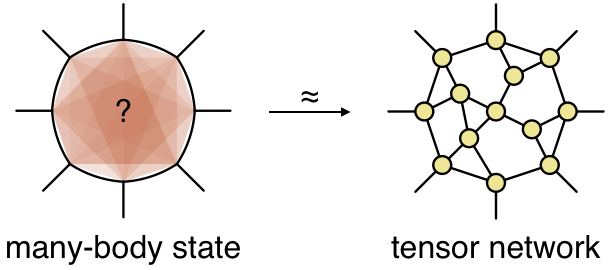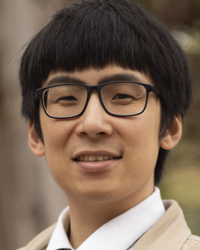The holographic duality, also known as AdS/CFT, was originally proposed as a correspondence between a \((d+1)\)-dimensional quantum field theory and a \((d+1)\)-dimensional quantum gravity theory. The holographic duality is named as such because it encodes information about the space-time geometry in the higher-dimensional holographic bulk into the quantum many-body dynamics on the lower-dimensional holographic boundary.

The holographic duality has revealed a deep connection between quantum entanglement and space-time geometry. As Brian Swingle stated in Quantum Magazine, “Entanglement is the fabric of space-time.” To better understand the structure of quantum entanglement in many-body systems, one can represent the quantum many-body wave function as a tensor network, as illustrated in the figure above. Each link in the network represents an entangled pair state, and each circle represents a measurement that projects the local degrees of freedom to a state in a measurement basis. The resulting quantum many-body state is formed by entangling the unmeasured degrees of freedom (the open ends of dangling links).
Although entangled pair states only possess local two-body entanglement, the resulting state can contain very complicated multi-body entanglement after the projective measurements. The tensor network representation effectively resolves the non-local multi-body entanglement structures in the many-body state as local pairwise network connectivity, at the price of introducing auxiliary tensors in the bulk of the network. The emergent bulk and its network geometry correspond to the holographic spatial geometry dual to the quantum many-body state.
Different bulk geometries, or tensor network connections, typically lead to different entanglement features in the tensor network state. Therefore, given the entanglement features of a many-body state, we can determine the optimal tensor network connectivity that best reproduces the given entanglement features. This problem resembles that of training a neural network. In our paper (arXiv:1709.01223), we show that optimizing the connectivity of a random tensor network to fit the entanglement features can be mapped to training a deep Boltzmann machine using machine learning techniques. As we serve the entanglement “big-data” to the machine, it develops a neural network to capture the features of the data. As the training goes on, the holographic spatial geometry emerges in the bulk as the network geometry grows deeper and deeper when we push the boundary quantum field theory towards the conformal limit.
